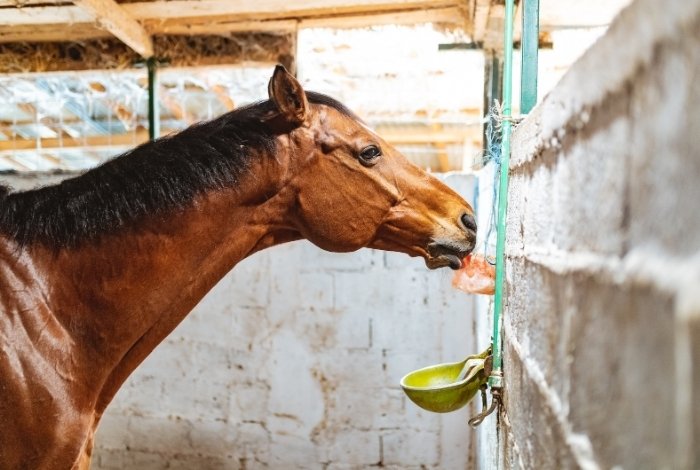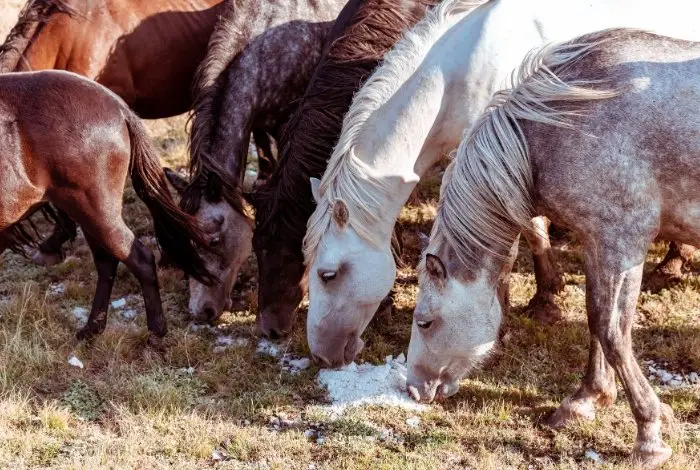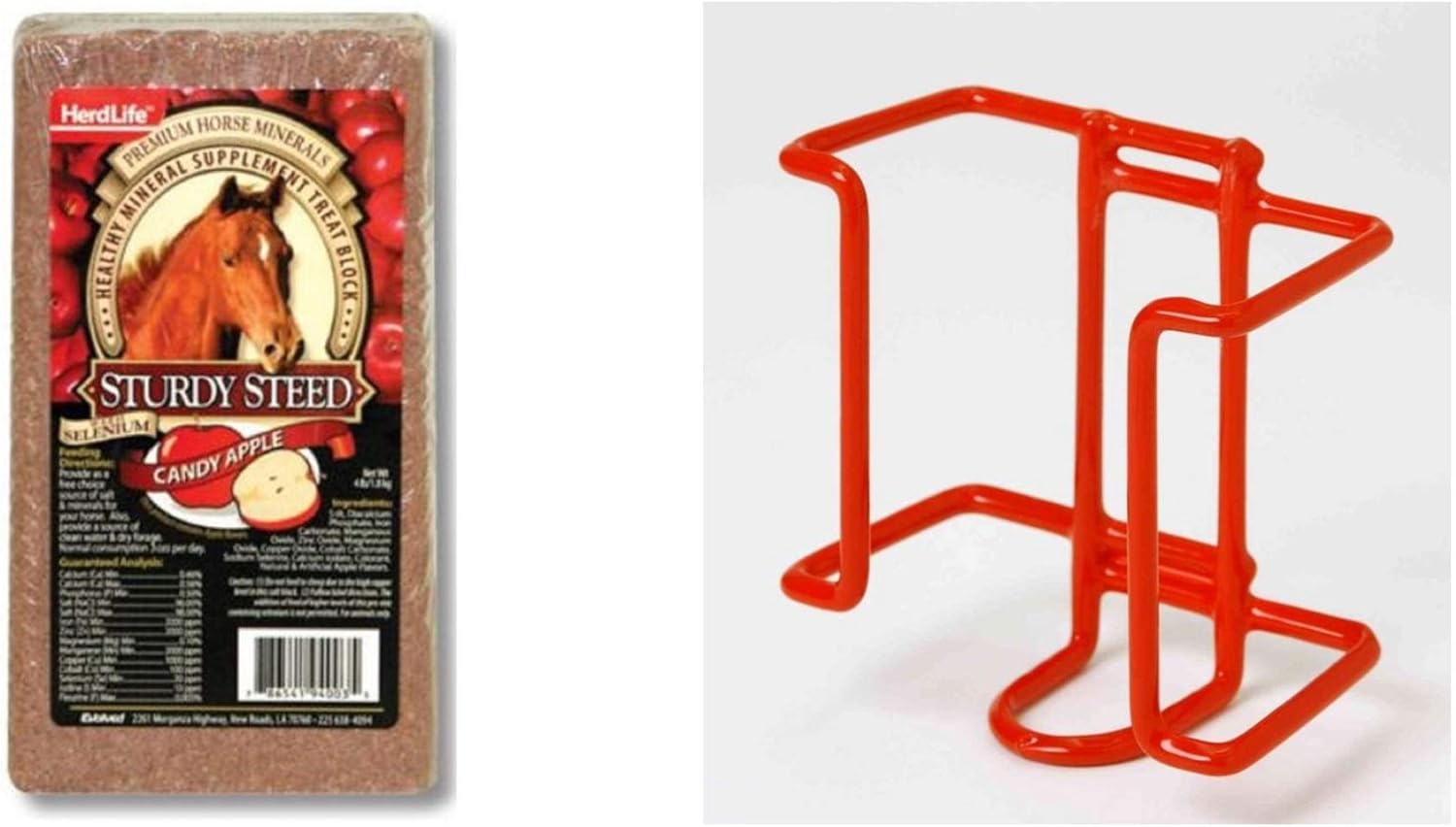Last Updated on December 26, 2022
Many new horses and livestock owners are surprised to learn their animals need salt. After all, salt is an essential nutrient which the body is not capable of producing. Luckily we have done our research to help you choose the best salt block for horses. The sodium and chloride in salt are what the horses need for optimal health. Sodium assists with protein digestion, muscle contractions, and nerve impulses. The chloride primarily maintains the pH balance of blood but also increases the efficiency in carbon dioxide transportation to their lungs. Horse sweat is also hypertonic, meaning it contains more salts than fluid. It is necessary to replenish these electrolytes, so salt intake is very important.
Purpose of Salt Block for Horses
Although horses receive some trace vitamins and minerals through grazing, grass and hay contain minimal sodium. Salt blocks were created as a sodium chloride source for horses and the most common form of supplementation. However, owners may notice added salt in concentrated hay cube formulas. On average, horses need 1-2 ounces of salt per day. This can greatly increase (upwards of 6 ounces per day) if horses are working and sweating in great quantity.
Unless forcefully administered by humans, horses will not naturally consume an over-abundance of salt. Salt toxicosis may be possible but usually occurs when water is extremely limited or completely inaccessible. A more likely scenario would be a salt deficiency. This can occur over a time span of several weeks or months. Deficiency symptoms include pica (eating unnatural or foreign things the animal wouldn’t normally touch) and frequent licking of anything that may have salt. If the deficiency is allowed to progress and remains uncorrected, horses may suffer from weight loss, dehydration, and loss of appetite in extreme cases. You can learn more about equine dehydration here. Yes, salt helps horses stay hydrated!
Read more about Why Using Rice Bran For Horses
Use
Salt blocks are best used as a “free-choice” item. This means horses should have daily access to blocks, but under normal circumstances does need to be intentionally fed or administered. Horses’ salt requirements are innate, and they will consume an appropriate amount if made available. Salt blocks are available in several varieties and sizes. There are specialty pans sold for salt block use, like this one here.
How to Select a Salt Block
Size and location are major factors in selecting a salt block. Some owners keep larger blocks in the pasture or turnout, while others have stall blocks. Typically, free access to any type of salt lick will be adequate for horses. However, if horses are unable to get an appropriate amount from licking, they will begin to chew the block.
Larger blocks are well-suited for pasture availability. Owners should ensure they are kept in an open area where all horses can access the block without becoming trapped by more senior herd members. Many horses enjoy a community salt block. However, weathering and temperature conditions can decrease the amount a block is utilized when out in the open without protection. Other horse owners prefer smaller stall blocks or even Himalayan rock salt ropes, so salt intake or usage can be easily monitored. This also ensures each horse has readily available access to salt as opposed to a shared pasture setting.
Types of Salts
Plain Salt
Salt blocks can be trace-mineralized or plain. The plain white salt blocks only contain sodium chloride. This is the most popular salt block, as it is a no-frills plain salt option.
Himalayan Salt
Himalayan rock salt is unprocessed. Although it does contain other minerals (both good and bad), the trace amounts are so minute it does not typically affect your horse in a positive or negative manner. Therefore, Himalayan salts are typically referred to as plain salts. However, the pink color is actually due to the mineral content. They are easy to hang and the texture is gentler on a horse’s tongue despite how hard they are. Because of the texture, they are more weather resistant than other salt blocks.
Trace Mineral Blocks For Horses
Trace mineral blocks contain sodium chloride and trace minerals like copper, zinc, iron, iodine, and manganese. Although there is not a significant amount of trace minerals, they can be beneficial if local soil/forage lacks trace minerals. Some red mineral blocks will also have added selenium, which many areas lack.
Learn more about Selenium Deficiencies in Horses
Alternatives
Salt blocks are not the only means of supplemental salt. However, salt licks are greatly preferred because it is a free-choice item. Although adding salt to feed allows owners to directly control salt intake, it removes the horse’s innate ability to consume the required amount. Some owners opt to feed loose salts if they notice their horse is starting to chew on a traditional salt block. Other owners choose to supplement with electrolyte formulas. These typically contain salt, calcium, potassium, and magnesium. Most electrolyte formulas are available in appealing flavors and can be given over food.
Recommended Products
Here are our top picks for salt blocks depending on what is suitable for your horse:
1. Horseman’s Pride Hanging Himalayan Rock Salt
Our first pick is this Himalayan rock salt on a rope by Horsemen’s Pride. They are available as a 2.2, 4.4, or 7.5-pound size, as well as a large brick form (it does not hang). The smaller sizes on a rope are also great boredom busters in the stall!
Pros:
- Comes with adjustable rope
- Withstands the elements
- Hard nature discourages chewing
- All-natural
Cons:
- Can become detached from the rope
2. North American White Salt Block for Horses
This is a no-frills standard white salt block by American Stockman. It comes as a 4-pound brick and has a 99% purity rating. This is one of the more weather-resistant variations of the plain salt blocks. Because it does not contain added trace minerals for a specific animal, it is appropriate for use in all species. This includes cattle, horses, sheep, and pigs! The only ingredients are salt, mineral oil, stearate, and calcium.
Pros:
- Simple
- Weather-resistant compared to similar products
Cons:
- N/A
3. Compressed Himalayan Salt Lick
We love this 5.5-pound block. It is made of 100% natural Himalayan salt with no additives or binding agents. This compressed block means there is an equal distribution of salt and minerals throughout the entire block. Edges are rounded for comfort when licking, and the block is suitable for all animals. This fits in most commercial salt pans, and the size makes it suitable for pasture use. This is optimal as Himalayan salt blocks withstand weather better than plain white blocks.
Pros:
- Block size for pasture use
- No additives
Cons:
- N/A
4. Herdlife Sturdy Steed Horse Mineral Salt Block with Added Selenium
These Sturdy Steed blocks are great for turnout or stall use. This one comes with a vinyl-coated wire holder with rounded corners for safety. The mineral blocks are 4-pounds and available in a variety of appealing flavors. This specific free-choice supplementation block is candy apple flavored to encourage horses to lick. Although available in a standard mineral option, many owners will opt for the added selenium.
Pros:
- Offers added selenium
- Great flavors
Cons:
- Provided holder does not fit well
5. Purina Animal Nutrition Free Balance Block
We love this mineral salt block for several reasons. It is specifically formulated for horses (which is preferred unless it is a shared pasture). The block offers both trace minerals and vitamins, with increased bioavailability. It is weather resistant making it suitable for pasture use and has added antioxidants including vitamin E.
Pros:
- Additional vitamins and antioxidants
- Weather-resistant
- Increased bioavailability
Cons:
- More expensive than traditional mineral blocks
Honorable Mention #1: Redmond Rock Crushed Loose Mineral Salt
Although this isn’t technically a salt “block”, we couldn’t leave Redmond salt out. If owners choose to dress their own feeds to administer salt, this product is an all-natural mineral sea salt. It is harvested in the USA from Southern Utah and contains more than 60 trace minerals. At 2 ounces per day, a 5-pound bag is roughly a 6-week supply.
Pros:
- Easily added to feed
- Controlled portions
Cons:
- Not designed for free-choice
Honorable Mention #2: Finish Line Apple-A-Day
Some owners are more comfortable giving an electrolyte blend rather than straight salt. Others love Apple-A-Day due to the appealing flavor, and the ability to encourage more water consumption. Apple-A-Day is made as an electrolyte/mineral (sodium) replacement. This is a concentrated and long-lasting formula and contains no sugars despite the delicious apple flavor!
Pros:
- Easily administered on food
- Great flavor
- No sugar
Cons:
- Not designed for free choice
Learn more about Loose Minerals For Horses; Are They Necessary?
Closing Thoughts
Pasture limitation and stabling can create many challenges in horse ownership. However, horses in captivity do not have different nutritional needs just because they are stabled. Fortunately, there are many great products on the market to help supplement horses’ salt needs and daily intake requirements.
The final salt product chosen is typically a matter of preference. The product must not only meet storage needs (in a stall, hanging, or in a pasture pan) but must appeal to the horse. Many “all species” blocks will not entice horses enough to encourage licking. Between the availability of salt blocks, mineral blocks, and feed dressings, you are sure to find the right solution for your animals.
Do you have friends with horses? Be sure to share this article!
How do horses get salt in the wild?
In the wild, the salt in the loose form can be found accumulated on rock surfaces and in sediments deposited around salt water sources and wild horses can travel long distances to find the areas rich in salt accumulations. Wild horses also have a different diet from domestic horses. They eat wide variety of plants and grasses that already contain salt and essential minerals that are crucial for normal functioning of the horse’s body. In captivity, a salt lick can be used to supplement their diets with salt.
Can a horse get too much salt?
It is very uncommon for horses to eat too much salt. But if it happens that they do eat too much salt and at the same time they don’t have the access to fresh water, the salt toxicity may occur. This may lead to colic, diarrhea, frequent urination, weakness, and recumbency. This condition is easy to prevent with making sure your horse always has the access to fresh drinking water.
Is Himalayan pink salt good for horses?
Himalayan pink salt is a popular ingredient in horse feed, and there are many opinions on its benefits. One common misconception is that it has some form of medicinal or nutritional value, when in fact it is just an unrefined form of salt. However, Himalayan pink salt has a high content of minerals (over 84 essential minerals) and is high in calcium which plays an important role in horse’s bones, joints, teeth, and hooves strength and health. It also contains magnesium which is vital for a healthy nervous system, heart, muscles, and nerves. Himalayan pink salt contains trace amounts of fluoride which is good for the teeth and gums. It also helps to reduce inflammation, allergies, and arthritis.
Do horses need salt blocks in summer?
Due to high temperatures in the summer that promote sweating, you should keep special care to ensure your horses have the access to salt blocks at all times. That will help them maintain the healthy balance of essential minerals that are excessively lost through the sweat. The salt blocks help horses maintain electrolyte balance. If horses don’t replace lost minerals the electrolyte imbalance can develop which may lead to low blood pressure or even neurological or cardiovascular problems in horses.
Do horses need salt blocks in winter?
Horses need to get enough minerals on daily basis, regardless the weather or the temperatures. During the winter they won’t be loosing that much essential minerals through sweat but salt blocks are still needed as salt helps to promote water consumption that is normally lower in cold weather, and therefore prevent dehydration.
It’s recommended that a salt block is always available to your horse.
How often should you give your horse a salt block?
Whereas it’s obvious that a horse needs minerals for good health, it’s not always so clear how much salt is “enough.” In general, a five-pound salt block should be enough for one horse for 2 months. Provide a salt lick in the pasture and/or paddock where your horse is fed. Make sure the lick is accessible and clean. If you have more than one horse, provide multiple salt blocks to avoid bullying and fighting over it.
Equestrian, Marine Corps vet, and Morgan horse enthusiast.









